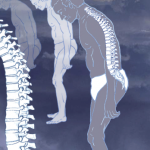Her team obtained two sequences: T1 and Short-TI Inversion Recovery (STIR). In her presentation, she showed the coronal oblique view, which revealed bone marrow edema as well as erosions consistent with active sacroiliitis. She concluded the patient had axSpA, and she noted that in his case, clinical features alone were not sufficient to diagnose him with axSpA.
For patients like this one, with a non-definitive radiograph and a suspicion of axSpA, she emphasized the importance of obtaining an MRI of the sacrum (not the lumbar spine).
Dr. Gensler next described a 29-year-old man who had experienced eight months of back pain. A radiograph of his pelvis was read as normal with no evidence of sclerosis or erosions. Moreover, an MRI of his sacrum showed no significant bone edema. Nevertheless, Dr. Gensler diagnosed the patient with axSpA based upon extensive structural changes of erosions and fat deposition visible on the T1 sequence that she described as having a high specificity and helping even in the absence of active sacroiliitis.
Imaging Challenges
Robert Lambert, MD, of the University of Alberta in Canada, elaborated on the imaging challenges but emphasized that because biological therapies are expensive, “[B]efore starting a biologic, every patient deserves to have one MRI scan.” He believes strongly in the importance of this baseline assessment.
Dr. Lambert presented the natural history of early disease as seen on MRI, focusing on a 22-year-old male with a family history of SpA. The young man was asymptomatic and had a normal X-ray. The team performed a research MRI scan of the sacroiliac joints and repeated it over time, and they found that not only did his disease not follow a consistent course, it evolved.
‘Before starting a biologic, every patient deserves to have one MRI scan.’ —Dr. Lambert
Not only does disease evolve, but imaging of the sacroiliac joints can be difficult to interpret because they have a high degree of anatomical variation, as well as multiple acute contour changes in the articular surface, Dr. Lambert said.2
Because MRI lesions occur commonly in normal controls, Dr. Lambert emphasized that clinicians must be skilled at recognizing structural lesions on T1-weighted MRI, and he suggested anyone seeking to better understand the use of MRI for spondyloarthritis should receive training directed at detection of lesions visible on T1-weighted MRI to improve use of MRI for the diagnosis of early SpA.


